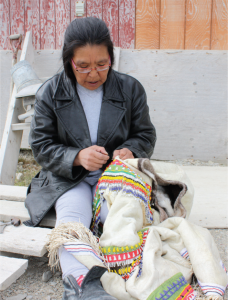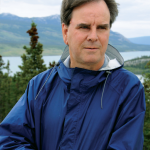Northern Restoration
Zacharias Kunuk brought oral culture into the digital age by creating his own form of journalism, one that tells stories from the inside out. And he's unrepentant about the one-sidedness of his approach
 Television first came to the North in the late 1960s at the request of mining companies that wanted to keep their transient workers occupied through long, dark Arctic winters with southern sitcoms and soap operas. No one consulted the local Inuit population. Transmissions were in French and English and came in one direction: in. One broadcaster, who watched children turn away from their parents and Inuktitut language in Frobisher Bay (now Iqaluit), compared TV to a neutron bomb that “destroys the soul of a people while leaving the shell of a people walking around intact.”
Television first came to the North in the late 1960s at the request of mining companies that wanted to keep their transient workers occupied through long, dark Arctic winters with southern sitcoms and soap operas. No one consulted the local Inuit population. Transmissions were in French and English and came in one direction: in. One broadcaster, who watched children turn away from their parents and Inuktitut language in Frobisher Bay (now Iqaluit), compared TV to a neutron bomb that “destroys the soul of a people while leaving the shell of a people walking around intact.”
Zacharias Kunuk, then an Inuk carver from Igloolik in what is now Nunavut, noticed that when television came, “everybody stopped listening, visiting one another and telling stories.” In 1975 and again in 1979, his hamlet rejected government offers to broadcast satellite signals from the South until Inuit had a broadcaster of their own. But Kunuk didn’t want to wait for Canada to restore his Inuit traditions. Born Atagutaluk Kigutikajuk Tagaaq Kuatuk Nujaktut, he was E5-1613 to the government, which rechristened him Kunuk. An Anglican priest called him Zacharias. Southern institutions had claimed enough of his culture. In 1981, the 24-year-old flew to Montreal and sold three of his carvings at Westmount’s Eskimo Art Gallery; he returned with a Sanyo beta camera, a VCR and a 26-inch television.
Kunuk tells only one story from one perspective: the Inuit one, and he tells it in his own language, Inuktitut. Inuit, he says, have gone from the Stone Age to the digital age in one generation, and he’s spent the past 30 years salvaging stories that were nearly forgotten in the transition from an oral culture to one where the written word determines political policy and power. In the process, he’s pressed the Canadian government to acknowledge past human rights offences against Inuit and challenged the effectiveness of the Nunavut Land Claims Agreement. He’s created his own form of journalism, one that tells stories from the inside out, and he’s unrepentant about the one-sidedness of that approach. Kunuk’s documentaries sketch the first draft of the losers’ history, and he’s not looking for input or approval from the winners.
“Has it been a bad week?” I ask. It’s early July in Igloolik, the sun hasn’t set in months and it’s stiflingly dusty. I’m at the dump with Kunuk, searching for a ball joint that will connect the wheel to the axle of his burgundy Jeep. His company has just gone into receivership. His equipment and costumes have been repossessed, his office doors are padlocked and the receiver has requested his computer and his vehicle registration. A week ago, he blew a tire on that car and, two days ago, the wheel fell off completely.
Kunuk pulls his head from the wheel well of a half-crushed pickup truck and stops searching for a match to the car part in his hand. We walk back to a borrowed four-wheeler and he finally answers my question.
“Kch!” It’s a quick, percussive sound—not exactly a laugh—that he makes when disaster strikes and, after two weeks in Igloolik, I’m starting to recognize it. He revs up the four-wheeler and yells, “It’s too hot for the helmet” (it’s seven degrees) and “Companies go bankrupt all the time. You just start a new one.”
As in many of Nunavut’s 25 hamlets, the houses of Igloolik are bound by the graveyard on one side and the airport on the other, creating the impression that the only way out is through death or the air. This is the Igloolik—and the Nunavut—I recognize from news 2012
reports. It’s the Nunavut of the southernized political system, the astronomical suicide rate, 40 percent unemployment, alcohol abuse and a century of cultural oppression. Ole Gjerstad, a Nunavut documentarian, says it’s a world portrayed so negatively in newspapers: “You walk away from those six to eight pages devoted to Nunavut and man, oh man, we may as well just nuke the whole place and liberate the planet from all that misery.”
But there are two Iglooliks: the town and the island. The name means “place of houses” and refers to the land around the town where Inuit settled before contact with southerners. Kunuk drives through dirt, boulders and soft brown tundra clods to show me another, ruined Igloolik where the political units were families and elders held sway. Suicides were rare and predominantly practiced by elders in times of scarcity. He has made close to 30 docs and two features in as many years and, though roughly half of them are set in modern Nunavut, he never loses sight of this world. We stop the Jeep and get out. The air is absolutely silent. It’s so windless that contrails from the morning flights crisscross like pencil lines through the sky.
“This is where we lived,” Kunuk says, pointing at a square-shaped welt in the grass where a sod house once stood, eight feet wide by eight feet deep. There are six more like it stretching down the coastline. It’s the site of a community that died only decades ago, but it’s not marked on any map. The day he left his sod house, Kunuk says, “was the saddest day of my life.”
To read the rest of this story, please see our ebook anthology: RRJ in Review: 30 Years of Watching the Watchdogs.
It can be purchased online here.
Ashleigh Gaul was the Head of Research of the Winter 2012 issue for the Ryerson Review of Journalism.













































